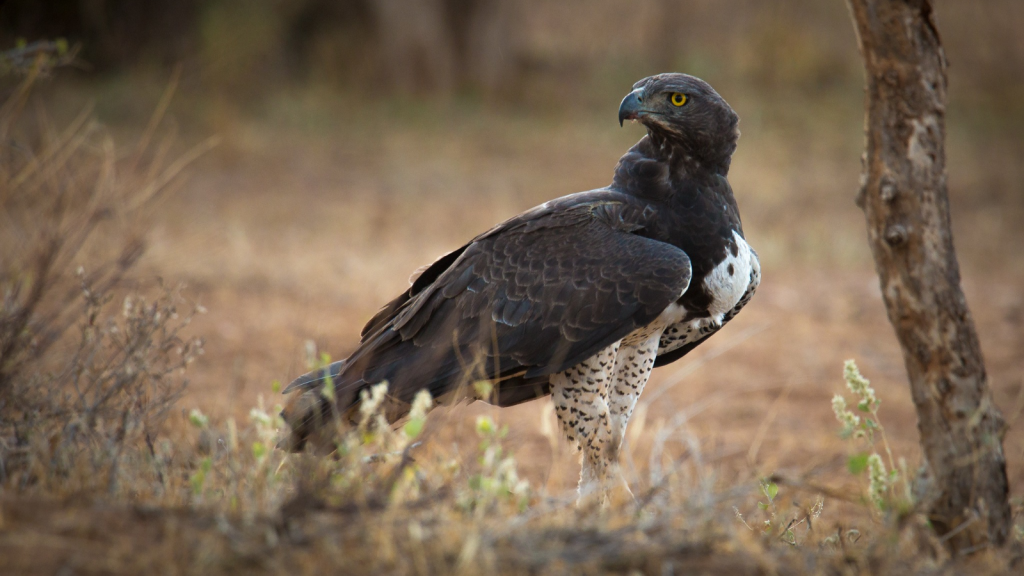The Kalahari Desert, a vast expanse of red sand and scrubland stretching across southern Africa, is home to an astonishing array of wildlife. Despite its harsh conditions, this semi-arid region supports a diverse ecosystem of plants and animals, many of which are found nowhere else on Earth. However, climate change, habitat loss, and human activities are putting immense pressure on the Kalahari’s unique inhabitants. From iconic big cats to lesser-known reptiles, many species are now facing the threat of extinction. Here are 12 endangered animals of the Kalahari Desert that desperately need our attention and conservation efforts.
1. African Wild Dog

Also known as the painted wolf, this highly social canine is one of Africa’s most endangered carnivores. African wild dogs live in packs and are known for their incredible hunting efficiency. With fewer than 6,600 individuals left in the wild, they face threats from habitat fragmentation, conflict with humans, and diseases spread by domestic dogs. Conservation efforts include establishing protected corridors between fragmented habitats to allow for greater range and genetic diversity.
2. Black Rhino

Once widespread across Africa, the black rhino population has been decimated by poaching. These browsers play a crucial role in shaping the Kalahari’s vegetation. Despite conservation efforts, black rhinos remain critically endangered, with only about 5,500 individuals left in the wild. Innovative anti-poaching measures, such as horn-embedded GPS trackers and increased patrol efforts, are being implemented to protect remaining populations.
3. Cheetah

The world’s fastest land animal is racing against extinction in the Kalahari. Cheetahs require vast territories, which brings them into conflict with farmers and livestock. Their low genetic diversity makes them vulnerable to diseases, and cub mortality is high due to predation by other carnivores. Conservationists are working with local communities to develop cheetah-friendly farming practices and establish protected wildlife corridors.
4. Pangolin

Often called “scaly anteaters,” pangolins are the world’s most trafficked mammals. The ground pangolin, found in the Kalahari, is hunted for its scales and meat. These shy, nocturnal creatures play a vital role in controlling insect populations, but all eight pangolin species are now threatened with extinction. Recent international trade bans and increased law enforcement efforts aim to curb the illegal pangolin trade.
5. Kalahari Lion

While lions are not yet globally endangered, the Kalahari subspecies faces significant threats. These magnificent cats have adapted to the desert environment, but habitat loss and conflict with humans have led to declining populations. Kalahari lions are known for their impressive black manes and ability to go without water for long periods. Conservation efforts focus on reducing human-lion conflict through improved livestock management and community education programmes.
6. Aardvark

This bizarre-looking mammal is sometimes called the “African ant bear.” Aardvarks are crucial ecosystem engineers, creating burrows that provide shelter for numerous other species. Climate change and the resulting food scarcity are major threats to aardvarks in the Kalahari. Researchers are studying how changes in temperature and rainfall patterns affect aardvark feeding behaviour and survival rates to inform conservation strategies.
7. Cape Vulture

As one of Africa’s largest raptors, the Cape vulture plays a vital role in the Kalahari ecosystem by cleaning up carcasses. These birds are endangered due to poisoning, both intentional and accidental, as well as collisions with power lines. Their decline could have serious implications for disease control in the region. Conservationists are working with energy companies to make power lines more visible to vultures and educating farmers about the dangers of using poison baits.
8. African Elephant

While more commonly associated with savannas, elephants do inhabit parts of the Kalahari. These gentle giants face threats from poaching and habitat loss. In the Kalahari, they play a crucial role in maintaining biodiversity by creating water holes and dispersing seeds. Conservation efforts include the creation of transfrontier parks to allow for natural elephant migration patterns and reduce human-elephant conflict.
9. Martial Eagle

As Africa’s largest eagle, this powerful raptor is a top predator in the Kalahari ecosystem. Martial eagles are endangered due to habitat loss, poisoning, and collisions with power lines. Their decline affects the balance of smaller predators and prey species in the desert. Satellite tracking studies are helping researchers understand Martial eagle movement patterns and identify critical habitats for protection.
10. Leopard Tortoise

While not yet officially endangered, the leopard tortoise population in the Kalahari is declining rapidly. These long-lived reptiles face threats from habitat destruction, road mortality, and collection for the pet trade. They play a crucial role in seed dispersal for many desert plants. Conservation efforts include the creation of tortoise crossings under roads and education programmes to discourage the illegal collection of wild tortoises.
11. Brown Hyena

Also known as the strandwolf, the brown hyena is the rarest of the hyena species. These shy, nocturnal scavengers are vital for the Kalahari ecosystem, cleaning up carrion and keeping disease at bay. Habitat loss and persecution by humans are their main threats. Research into brown hyena behaviour and ecology is helping to develop more effective conservation strategies, including the use of livestock guardian dogs to reduce conflict with farmers.
12. Kori Bustard

As the heaviest flying bird native to Africa, the Kori bustard is an impressive sight in the Kalahari. These birds are vulnerable to habitat loss, hunting, and collisions with power lines. Their decline affects the dispersal of seeds and insects across the desert landscape. Conservation efforts include habitat protection, anti-poaching measures, and the development of eco-tourism initiatives to create economic incentives for local communities to protect these magnificent birds.



